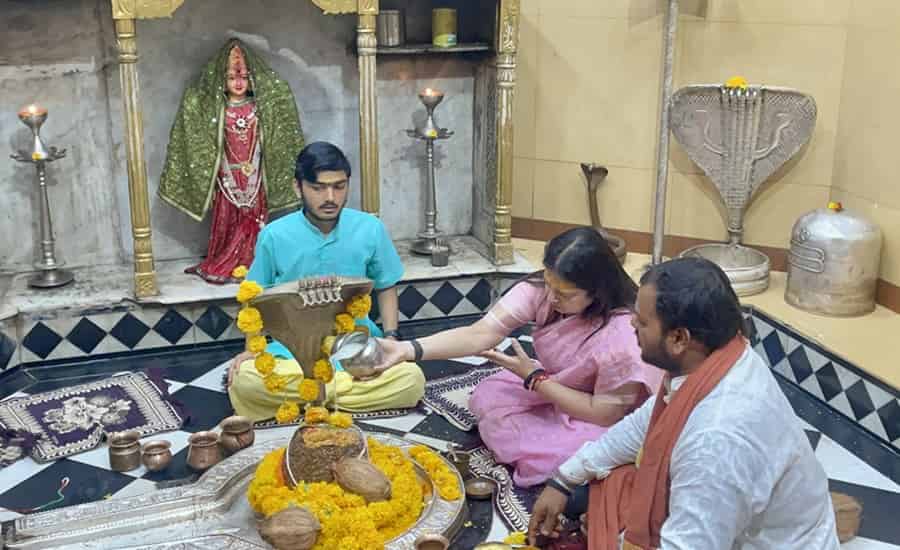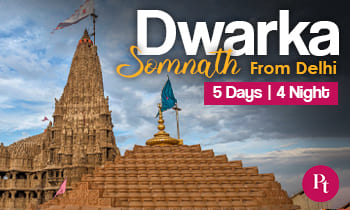Nageshwar Jyotirlinga Temple, located in the scenic town of Dwarka in the western state of Gujarat, India, is one of the twelve Jyotirlingas dedicated to Lord Shiva. This sacred site holds immense significance in Hindu mythology and attracts pilgrims from far and wide who seek the divine blessings of Lord Shiva. The temple has a rich history, and its rituals and timings play a crucial role in the spiritual experience of the devotees.
- Darshan Timings 6:00 AM to 9:00 PM
- Entry Fee: Free
- Best Time to Visit: March and October

Historical Significance
The Nageshwar Jyotirlinga Temple is believed to be associated with the powerful narrative of the demon couple Daruka and Daruki. According to mythology, the demons sought a boon from the creator, Lord Brahma, to be invincible. However, with their newfound powers, they became tyrants and started tormenting the celestial beings and sages.
The distressed deities prayed to Lord Shiva for protection. Hearing their pleas, Lord Shiva emerged as a fiery column of light, and in a fierce battle, he vanquished the demons. The Nageshwar Jyotirlinga is believed to be the spot where Lord Shiva manifested as a fiery pillar to rescue the gods from the tyranny of Daruka and Daruki.
Temple Architecture
The temple stands as a magnificent example of ancient Hindu architecture. The main sanctum houses the Shiva Linga, which is the main deity of the temple. The lingam is believed to be swayambhu, meaning it manifested on its own. The temple complex also includes smaller shrines dedicated to various deities, adding to the spiritual aura of the place.
Temple Timings
The Nageshwar Jyotirlinga Temple follows a strict schedule, and devotees plan their visits according to the prescribed timings. The temple generally opens its doors early in the morning and remains open throughout the day, closing in the evening. The specific timings may vary on special occasions, festivals, and during religious ceremonies.
- Darshan: 6 AM 9 PM
- Shringar Darshan: 4 PM 4:30 PM
- Shayan Aarti: 7 PM 7:30 PM
- Nightly Aarti: 9 PM 9:30 PM
Morning Timings: The temple usually opens at the crack of dawn, providing devotees with the opportunity to start their day with prayers and rituals. Morning prayers are considered particularly auspicious, and witnessing the first rays of the sun at the temple is believed to be a spiritually enriching experience.
Afternoon Break: Like many temples in India, Nageshwar Jyotirlinga Temple observes a break during the afternoon. This period allows the temple priests to perform necessary rituals and preparations for the evening prayers.
Evening Timings: The temple reopens in the evening, creating a serene ambiance as the sun sets. The evening prayers and aarti (ritual of worship) are especially vibrant, accompanied by the melodious chants and bhajans (devotional songs) that fill the air.
Closing Time: The temple closes its doors to the public after the evening rituals are complete. Devotees are encouraged to visit the temple during the prescribed timings to fully participate in the divine atmosphere and seek the blessings of Lord Shiva.
Rituals and Pujas
The daily rituals and pujas performed at the Nageshwar Jyotirlinga Temple are an integral part of the spiritual experience for the devotees. The temple priests meticulously follow a set pattern of worship, adhering to the traditions passed down through generations.
Mangala Aarti: The day often begins with the Mangala Aarti, a ritual of offering prayers and hymns to Lord Shiva early in the morning. This sacred ceremony is believed to invoke the divine blessings and set a positive tone for the rest of the day.
Shringar Puja: The Shringar Puja involves adorning the Shiva Linga with various sacred items, including flowers, sandalwood paste, and holy ash. This ritual is performed with utmost devotion and is accompanied by the chanting of Vedic mantras.
Bilva Archana: The offering of bilva leaves, also known as the sacred leaves of the bael tree, is considered highly auspicious in the worship of Lord Shiva. Devotees often participate in the Bilva Archana as a way to express their reverence and seek the Lord’s blessings.
Rudrabhishek: The Rudrabhishek is a special puja where the Shiva Linga is bathed with various substances, including milk, honey, ghee, and water. This elaborate ritual is performed with great devotion and is believed to cleanse the devotee of sins and bestow divine grace.
Evening Aarti: The evening aarti is a grand ceremony, marked by the illumination of lamps, the ringing of bells, and the singing of devotional songs. Devotees gather to witness this spiritual spectacle, offering their prayers and gratitude to Lord Shiva.
Festivals and Special Occasions
Nageshwar Jyotirlinga Temple comes alive during festivals and special occasions, attracting a larger influx of devotees. Some of the major festivals celebrated at the temple include Mahashivaratri, Kartik Purnima, and Shravan Mas (the holy month dedicated to Lord Shiva).
Mahashivaratri: This festival holds immense significance for Lord Shiva devotees. The temple witnesses an extraordinary gathering of pilgrims during Mahashivaratri, as they engage in night-long prayers, fasting, and participate in the special rituals performed by the temple priests.
Kartik Purnima: Celebrated on the full moon day of the Hindu month of Kartik, this festival is dedicated to Lord Shiva. Pilgrims take a holy dip in the nearby Gomti River and then visit the temple to seek the blessings of Nageshwar Jyotirlinga.
Shravan Mas: The entire month of Shravan is considered auspicious for Lord Shiva worship. Devotees observe fasts, visit temples, and engage in prayer and meditation to seek the divine grace of Lord Shiva. The temple sees a surge in pilgrim activity during this sacred month.
Conclusion
Nageshwar Jyotirlinga Temple stands as a symbol of devotion and spirituality, drawing people from different walks of life to experience the divine presence of Lord Shiva. The rich history, awe-inspiring architecture, and the meticulously performed rituals contribute to the temple’s significance in the Hindu religious landscape.
Devotees who visit the Nageshwar Jyotirlinga Temple not only seek solace and blessings but also actively participate in the age-old traditions that connect them to the divine. The temple’s timings and rituals create a structured and sacred environment, allowing individuals to immerse themselves in the profound spirituality that permeates every corner of this revered pilgrimage site.
Also Read:




 Call
Call WhatsApp
WhatsApp Enquiry
Enquiry
Do you provide cab services for Somnath and Nageshwar and Dwarka sight seeing
Timing of Rudrabhishek of Nageshwar Jyotirlinga and charges